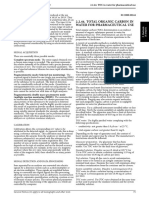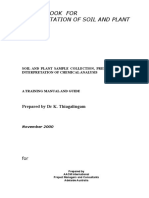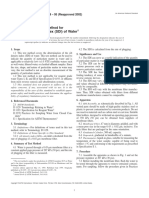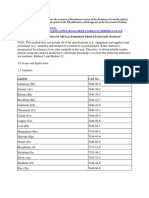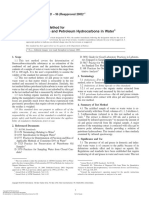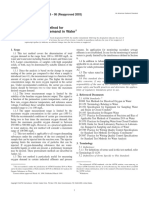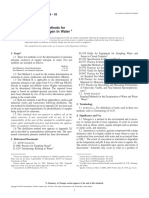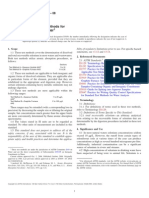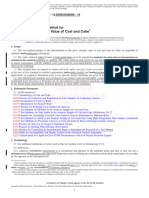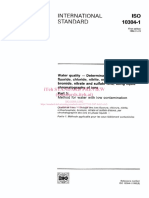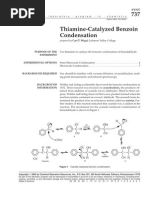EPA Method - 418 - 1-Total Petroleum Hydrocarbons
EPA Method - 418 - 1-Total Petroleum Hydrocarbons
Uploaded by
Meetika GuptaCopyright:
Available Formats
EPA Method - 418 - 1-Total Petroleum Hydrocarbons
EPA Method - 418 - 1-Total Petroleum Hydrocarbons
Uploaded by
Meetika GuptaOriginal Title
Copyright
Available Formats
Share this document
Did you find this document useful?
Is this content inappropriate?
Copyright:
Available Formats
EPA Method - 418 - 1-Total Petroleum Hydrocarbons
EPA Method - 418 - 1-Total Petroleum Hydrocarbons
Uploaded by
Meetika GuptaCopyright:
Available Formats
METHOD #: 418.
1 TITLE:
(Issued 1978) Petroleum Hydrocarbons (Spectrophotometric, Infrared) Petroleum Hydrocarbons IR 45501
ANALYTE: INSTRUMENTATION: STORET No.
1.0
Scope and Application 1.1 1.2 This method is for the measurement of fluorocarbon-113 extractable petroleum hydrocarbons from surface and saline waters, industrial and domestic wastes. The method is applicable to measurement of light fuels, although loss of about half of any gasoline present during the extraction manipulations can be expected. The method is sensitive to levels of 1 mg/L and less, and may be extended to ambient monitoring.
1.3
2.0
Summary of Method 2.1 The sample is acidified to a low pH ( < 2) and serially extracted with fluorocarbon-113 in a separatory funnel. Interferences are removed with silica gel adsorbent. Infrared analysis of the extract is performed by direct comparison with standards.
3.0
Definitions 3.1 As in the case of Oil and Grease, the parameter of Petroleum Hydrocarbons is defined by the method. The measurement may be subject to interferences and the results should be evaluated accordingly. Oil and Grease is a measure of biodegradable animal greases and vegetable oils along with the relative non-biodegradable mineral oils. Petroleum hydrocarbons is the measure of only the mineral oils. Maximum information may be obtained using both methods to measure and characterize oil and grease of all sources.
3.2
4.0
Sampling and Storage 4.1 A representative sample of 1 liter volume should be collected in a glass bottle. Because losses of grease will occur on sampling equipment, the collection of a composite sample is impractical. The entire sample is consumed by this test; no other analyses may be performed using aliquots of the sample. A delay between sampling and analysis of greater than 4 hours requires sample preservation by the addition of 5 mL HCl (6.1). A delay of greater than 48 hours also requires refrigeration for sample preservation.
4.2
5.0
Apparatus 5.1 5.2 5.3 5.4 5.5 Separatory funnel, 2000 ml, with Teflon stopcock. Filter paper, Whatman No. 40, 11 cm. Infrared spectrophotometer, scanning or fixed wavelength, for measurement around 2950 cm-1. Cells, 10 mm, 50 mm, and 100 mm pathlength, sodium chloride or infrared grade glass. Magnetic stirrer, with Teflon coated stirring bars.
6.0
Reagents 6.1 6.2 6.3 6.4 Hydrochloric acid, 1:1. Mix equal volumes of conc HCl and distilled water. Fluorocarbon-113,(1,1,2-trichloro-1,2,2-trifluoroethane), b.p. 48C. Sodium sulfate, anhydrous crystal. Silica gel, 60-200 mesh, Davidson Grade 950 or equivalent. Should contain 1-2% water as defined by residue test at 130C. Adjust by overnight equilibration if needed. Calibration mixtures 6.5.1 Reference oil: Pipet 15.0 mL n-hexadecane, 15.0 mL isooctane, and 10.0 mL chlorobenzene into a 50 mL glass stoppered bottle. Maintain the integrity of the mixture by keeping stoppered except when withdrawing aliquots. 6.5.2 Stock standard: Pipet 1.0 mL reference oil (6.5.1) into a tared 200 mL volumetric flask and immediately stopper. Weigh and dilute to volume with fluorocarbon-113. 6.5.3 Working standards: Pipet appropriate volumes of stock standard (6.5.2) into 100 mL volumetric flasks according to the cell pathlength to be used. Dilute to volume with fluorocarbon-113. Calculate concentration of standards from the stock standard.
6.5
7.0
Procedure 7.1 Mark the sample bottle at the water meniscus for later determination of sample volume. If the sample was not acidified at time of collection, add 5 mL hydrochloric acid (6.1) to the sample bottle. After mixing the sample, check the pH by touching pH-sensitive paper to the cap to insure that the pH is 2 or lower. Add more acid if necessary. Pour the sample into a separatory funnel. Add 30 mL fluorocarbon-113 (6.2) to the sample bottle and rotate the bottle to rinse the sides. Transfer the solvent into the separatory funnel. Extract by shaking vigorously for 2 minutes. Allow the layers to separate. Filter the solvent layer through a funnel containing solvent-moistened filter paper into a 100 mL volumetric flask. NOTE 1: An emulsion that fails to dissipate can be broken by pouring about 1 g sodium sulfate (6.3) into the filter paper cone and slowly draining the emulsion through the salt. Additional 1 g portions can be added to the cone as required. Repeat (7.3 and 7.4) twice more with 30 mL portions of fresh solvent, combining all solvent into the volumetric flask.
7.2 7.3
7.4
7.5
7.6
7.7
7.8
Rinse the tip of the separatory funnel, filter paper, and the funnel with a total of 5-10 mL solvent and collect the rinsings in the flask. Dilute the extract to 100 mL. If the extract is known to contain greater than 100 mg of non-hydrocarbon organic material, pipet an appropriate portion of the sample to a 100 mL volumetric and dilute to volume. Discard about 5-10 mL solution from the volumetric flask. Add 3 g silica gel (6.4) and a stirring bar; stopper the volumetric flask, and stir the solution for a minimum of 5 min on a magnetic stirrer. Select appropriate working standards and cell pathlength according to the following table of approximate working ranges: Pathlength 10 mm 50 mm 100 mm Range 2-40 mg 0.5-8 mg 0.1-4 mg
7.9
7.10
Calibrate the instrument for the appropriate cells using a series of working standards (6.5.3). It is not necessary to add silica gel to the standards. Determine absorbance directly for each solution at the absorbance maximum at about 2930 cm-1. Prepare a calibration plot of absorbance vs. mg petroleum hydrocarbons per 100 mL solution. After the silica gel has settled in the sample extract, fill a clean cell with solution and determine the absorbance of the extract. If the absorbance exceeds 0.8 prepare an appropriate dilution. NOTE 2: The possibility that the absorptive capacity of the silica gel has been exceeded can be tested at this point by adding another 3.0 g silica gel to the extract and repeating the treatment and determination. Determine the concentration of petroleum hydrocarbons in the extract by comparing the response against the calibration plot.
8.0
Calculations 8.1 Calculate the petroleum hydrocarbons in the sample using the formula:
where: R = mg of Petroleum Hydrocarbons as determined from the calibration plot (7.10). D = extract dilution factor, if used. V = volume of sample, in liters. 9.0 Precision and Accuracy 9.1 Precision and accuracy data are not available at this time.
You might also like
- Elemental Analysis of Distillate Products by Inductively Coupled Plasma Mass Spectrometry (ICP-MS)Document13 pagesElemental Analysis of Distillate Products by Inductively Coupled Plasma Mass Spectrometry (ICP-MS)Essam Eldin Metwally AhmedNo ratings yet
- ASTM D1126-17 Método Estantar para Medicion de La Dureza en AguaDocument4 pagesASTM D1126-17 Método Estantar para Medicion de La Dureza en AguaSebastian SanChez100% (6)
- Astm E449 - 08Document5 pagesAstm E449 - 08samiwarraich519100% (2)
- E359 - 17 PDFDocument11 pagesE359 - 17 PDFĐặng Anh TrungNo ratings yet
- 2.2.44. Total Organic Carbon in Water For Pharmaceutical UseDocument2 pages2.2.44. Total Organic Carbon in Water For Pharmaceutical UseMulayam Singh Yadav100% (1)
- Mho/cm. This Procedure Automatically Adjusts Cell ConDocument3 pagesMho/cm. This Procedure Automatically Adjusts Cell ConRonald Figo Torres EcheNo ratings yet
- 75 Thiagalingam2003Document49 pages75 Thiagalingam2003JOSE HERNANDEZ CORASPE100% (1)
- Astm D-4189Document3 pagesAstm D-4189Rafael De la cruz MaquerhuaNo ratings yet
- D4185Document8 pagesD4185Fredi Cari CarreraNo ratings yet
- PH of Water: Standard Test Methods ForDocument10 pagesPH of Water: Standard Test Methods ForSaravanan NatesanNo ratings yet
- D 5149 - 02 - Ozone in AtmosphereDocument5 pagesD 5149 - 02 - Ozone in AtmosphereAny DBs'uNoNo ratings yet
- Chemical Analysis of Limestone, Quicklime, and Hydrated LimeDocument39 pagesChemical Analysis of Limestone, Quicklime, and Hydrated LimeHồng Nguyễn100% (1)
- Selection Guidelines For Dry Gas SealsDocument26 pagesSelection Guidelines For Dry Gas SealsVivek Rathod100% (3)
- Astm D7066Document9 pagesAstm D7066Nawawi Khalimi100% (2)
- Management Systems in Laboratories Engaged in Analysis of WaterDocument12 pagesManagement Systems in Laboratories Engaged in Analysis of Watermkaseem74100% (1)
- D 3921 - 2003Document7 pagesD 3921 - 2003THANGVU100% (1)
- ASTM D1607-91 (2005) Standard Test Method For Nitrogen Dioxide Content of The Atmosphere (Griess-Saltzman ReacDocument6 pagesASTM D1607-91 (2005) Standard Test Method For Nitrogen Dioxide Content of The Atmosphere (Griess-Saltzman ReacArif WibisonoNo ratings yet
- Method EPA Air PDFDocument333 pagesMethod EPA Air PDFCaleb ConnerNo ratings yet
- AN023 - US EPA Method TO 15 Volatile Organic Compounds in Ambient Air - 2019.1 1 PDFDocument3 pagesAN023 - US EPA Method TO 15 Volatile Organic Compounds in Ambient Air - 2019.1 1 PDFDiego Armando Cruz SerranoNo ratings yet
- International Standard: Soil Quality - Sampling - Guidance On Sampling TechniquesDocument7 pagesInternational Standard: Soil Quality - Sampling - Guidance On Sampling TechniquesYanka IlarionovaNo ratings yet
- Down FileDocument12 pagesDown FileSalma FarooqNo ratings yet
- Titulacion Petroleum IndustryDocument96 pagesTitulacion Petroleum Industryluis hernandezNo ratings yet
- EPA 29 MethodDocument36 pagesEPA 29 MethodGonzalo RosadoNo ratings yet
- Norma ASTM G140Document2 pagesNorma ASTM G140Jaqueline Gutierrez RobledoNo ratings yet
- Determination of Acid-Insoluble Residue in Biomass: Standard Test Method ForDocument3 pagesDetermination of Acid-Insoluble Residue in Biomass: Standard Test Method ForMadhanNo ratings yet
- Envirnomental Analysis 0Document48 pagesEnvirnomental Analysis 0Wayaya2009No ratings yet
- Astm D-1266 PDFDocument11 pagesAstm D-1266 PDFDzia RizqiNo ratings yet
- ASTM D6522-00 Determination of NOx, CO, and O2 Concentrations in Emissions Using Portable AnalyzersDocument9 pagesASTM D6522-00 Determination of NOx, CO, and O2 Concentrations in Emissions Using Portable AnalyzersFredi Cari Carrera100% (1)
- Astm d1126 2002Document5 pagesAstm d1126 2002Marco Ccotohuanca LagunaNo ratings yet
- ASTM D1126 Durezas en AguaDocument4 pagesASTM D1126 Durezas en AguafamturboNo ratings yet
- Chloride Ion in Water: Standard Test Methods ForDocument9 pagesChloride Ion in Water: Standard Test Methods ForSaravanan Natesan100% (2)
- Do Method Astm d5543Document6 pagesDo Method Astm d5543fawad_aNo ratings yet
- ASTM D3921 Grasas y Aceites en AguaDocument7 pagesASTM D3921 Grasas y Aceites en AguafamturboNo ratings yet
- ASTM D1067 Acidez o Alcalinidad de AguaDocument8 pagesASTM D1067 Acidez o Alcalinidad de AguafamturboNo ratings yet
- D6238Document7 pagesD6238Alaa NoureldeenNo ratings yet
- D513 16Document9 pagesD513 16Ricardo Aguirre100% (1)
- Astm G 91 - 97 - RZKXDocument5 pagesAstm G 91 - 97 - RZKXSamuel Eduardo100% (1)
- Astm D1607-91 (2018)Document5 pagesAstm D1607-91 (2018)MAR�A F�TIMA COASACA CAMACHONo ratings yet
- Stanhope Seta Product Catalogue 2010 72Document180 pagesStanhope Seta Product Catalogue 2010 72Reinaldo Alexandre Fonseca100% (3)
- Astm D-5576Document3 pagesAstm D-5576williamcondoriNo ratings yet
- D1691-12 Standard Test Methods For Zinc in Water PDFDocument7 pagesD1691-12 Standard Test Methods For Zinc in Water PDFammarNo ratings yet
- ASTM E135 08e1Document2 pagesASTM E135 08e1IMEDAL AluminioNo ratings yet
- Analysis of 1,3-Butadiene Product: Standard Guide ForDocument3 pagesAnalysis of 1,3-Butadiene Product: Standard Guide ForahmedNo ratings yet
- Calculation and Adjustment of The Langelier Saturation Index For Reverse OsmosisDocument4 pagesCalculation and Adjustment of The Langelier Saturation Index For Reverse OsmosisMirian Astete RojasNo ratings yet
- Total Carbon, Inorganic Carbon, and Organic Carbon in Water by Ultraviolet, Persulfate Oxidation, and Membrane Conductivity DetectionDocument7 pagesTotal Carbon, Inorganic Carbon, and Organic Carbon in Water by Ultraviolet, Persulfate Oxidation, and Membrane Conductivity Detectionvelu.gNo ratings yet
- ASTM D5159 - Standard Guide For Dusting Attrition of Granular Activated CarbonDocument4 pagesASTM D5159 - Standard Guide For Dusting Attrition of Granular Activated CarbonPrabu ArNo ratings yet
- D 6919-03 (TDS by Calculating) Dissolved Alkali and Alkaline EarthDocument9 pagesD 6919-03 (TDS by Calculating) Dissolved Alkali and Alkaline EarthhydrogenperoksideNo ratings yet
- Calculation and Adjustment of The Langelier Saturation Index For Reverse OsmosisDocument4 pagesCalculation and Adjustment of The Langelier Saturation Index For Reverse OsmosisNatalia RuizNo ratings yet
- Standard Guide For Selection of Geometric Conditions For Measurement of Reflection and Transmission Properties of MaterialsDocument8 pagesStandard Guide For Selection of Geometric Conditions For Measurement of Reflection and Transmission Properties of MaterialsviverefeliceNo ratings yet
- Astm D 1426 - 03 AmoniaDocument7 pagesAstm D 1426 - 03 AmoniahydrogenperoksideNo ratings yet
- ASTM D3859.1547159-1 (Se)Document11 pagesASTM D3859.1547159-1 (Se)evidjNo ratings yet
- Electrical Conductivity and Resistivity of Water: Standard Test Methods ForDocument8 pagesElectrical Conductivity and Resistivity of Water: Standard Test Methods Forfranz_passariniNo ratings yet
- Astm 2913 MercaptanoDocument4 pagesAstm 2913 MercaptanoRaymi MorenoNo ratings yet
- ISO 18400 Soil Quality-Sampling 107 Doccument and ReportingDocument15 pagesISO 18400 Soil Quality-Sampling 107 Doccument and ReportingahmadmohammadNo ratings yet
- Astm D5865 D5865M 19Document10 pagesAstm D5865 D5865M 19Naza NafisaNo ratings yet
- Sulfate Ion in Water: Standard Test Method ForDocument4 pagesSulfate Ion in Water: Standard Test Method ForasmybablooNo ratings yet
- Liquid Chromatography of Ions CL BR ISO-10304-1-1992Document11 pagesLiquid Chromatography of Ions CL BR ISO-10304-1-1992maría joséNo ratings yet
- ISO 9963 1 1994 en PreviewDocument3 pagesISO 9963 1 1994 en PreviewDeangelis DamasNo ratings yet
- Chevron - EPA Method - 413 - 2-HydrocarbonDocument3 pagesChevron - EPA Method - 413 - 2-HydrocarbonErvie J CauncaNo ratings yet
- USEPA 413.2-1983 - Oil and GreaseDocument3 pagesUSEPA 413.2-1983 - Oil and GreaseVirdaYuandhaNo ratings yet
- Total Sulphur ContentDocument3 pagesTotal Sulphur ContentpbipkgNo ratings yet
- Application of Fluorescence Spectroscopy For Spectral Discrimination of Crude Oil SamplesDocument8 pagesApplication of Fluorescence Spectroscopy For Spectral Discrimination of Crude Oil SamplesMeetika GuptaNo ratings yet
- FT-IR Analysis of Used Lubricating OilsDocument4 pagesFT-IR Analysis of Used Lubricating OilsMeetika Gupta100% (1)
- Bead FRMTNDocument9 pagesBead FRMTNMeetika GuptaNo ratings yet
- Bead FRMTN HHHDocument5 pagesBead FRMTN HHHMeetika GuptaNo ratings yet
- Alginte Beads FRMTNDocument8 pagesAlginte Beads FRMTNMeetika GuptaNo ratings yet
- AlginateDocument12 pagesAlginateMeetika Gupta100% (2)
- Aerobic Biodegrdtn of PhenolDocument41 pagesAerobic Biodegrdtn of PhenolMeetika GuptaNo ratings yet
- Actvtd CRBN Adsorption of PhnolDocument4 pagesActvtd CRBN Adsorption of PhnolMeetika GuptaNo ratings yet
- 50 MG Per L PhenolDocument6 pages50 MG Per L PhenolMeetika GuptaNo ratings yet
- GORE Cooling Filters DSH WEBDocument4 pagesGORE Cooling Filters DSH WEBBruno Gonçalves FernandesNo ratings yet
- Exp1-Solubility and RecrystallizationDocument6 pagesExp1-Solubility and RecrystallizationivvNo ratings yet
- Infinite Impulse Response Filter DesignDocument6 pagesInfinite Impulse Response Filter DesignfrankNo ratings yet
- 12Document12 pages12api-3708473No ratings yet
- MPT - 062015 PDFDocument62 pagesMPT - 062015 PDFanjangandak2932No ratings yet
- Filter Regulator LFR-3/4-D-MAXI-A: Data SheetDocument1 pageFilter Regulator LFR-3/4-D-MAXI-A: Data SheetAnonymous Y2J3QRfdNo ratings yet
- Dry Stack Tailings: Prepared ForDocument6 pagesDry Stack Tailings: Prepared ForDinda AmeliaNo ratings yet
- PolyaireProductCatalogueEdition1 GrillesDocument33 pagesPolyaireProductCatalogueEdition1 GrillesResi Air OrdersNo ratings yet
- 12 Pi 009 3 Aide Memoire On UtilitiesDocument11 pages12 Pi 009 3 Aide Memoire On UtilitiesAndreea OlaruNo ratings yet
- Universal's Unicl (Causticized Lignite) - 1Document11 pagesUniversal's Unicl (Causticized Lignite) - 1Maung OoNo ratings yet
- Andritz Dynamic Crossflow FiltrationDocument4 pagesAndritz Dynamic Crossflow Filtrationtarek555No ratings yet
- GT Datasheet DuraVeeDocument2 pagesGT Datasheet DuraVeeUmair PervaizNo ratings yet
- Achieving Zero Discharge in Industrial Waste Water Treatment PlantsDocument13 pagesAchieving Zero Discharge in Industrial Waste Water Treatment PlantsEswaramoorthi Sellappa GounderNo ratings yet
- 10-TR-98EN, Rev E - Off HighwayDocument7 pages10-TR-98EN, Rev E - Off HighwayCristian CastroNo ratings yet
- Module 3 AT11Document16 pagesModule 3 AT11christianpaulbromaNo ratings yet
- Sitagliptin Phosphate TabletsDocument3 pagesSitagliptin Phosphate TabletsNaeem MalikNo ratings yet
- Catch BasinDocument73 pagesCatch BasinAmany AdelNo ratings yet
- EM-SCI 2 (Slide 2)Document111 pagesEM-SCI 2 (Slide 2)Louisse Del CastilloNo ratings yet
- Lost CirculationDocument24 pagesLost CirculationAboZaidNo ratings yet
- KingspanWater User ManualDocument16 pagesKingspanWater User ManualYasin ArafatNo ratings yet
- Turbo Tek Er2 W5 P5 Filter ElementDocument2 pagesTurbo Tek Er2 W5 P5 Filter ElementCihan YasarNo ratings yet
- DIY Pool Reference Cards PDFDocument26 pagesDIY Pool Reference Cards PDFScott FullerNo ratings yet
- Diffusion Vs MillingDocument4 pagesDiffusion Vs MillingcbqucbquNo ratings yet
- Lec 1 Properties and Handling of Particulate SolidsDocument95 pagesLec 1 Properties and Handling of Particulate SolidsAli HasSsanNo ratings yet
- Discstar-G 11 2014 e PDFDocument2 pagesDiscstar-G 11 2014 e PDFjpsingh75No ratings yet
- I1011211051 - Anggi Putri Hamerson - Laporan Praktikum Fisiologi Modul SelGen - DikonversiDocument25 pagesI1011211051 - Anggi Putri Hamerson - Laporan Praktikum Fisiologi Modul SelGen - DikonversiANGGI PUTRI HAMERSONNo ratings yet
- Engine Oil Filter StudyDocument15 pagesEngine Oil Filter StudyJubril AkinwandeNo ratings yet
- Lab Report 1 Gravimetric Analysis SolutionDocument11 pagesLab Report 1 Gravimetric Analysis SolutionpreteamayNo ratings yet




